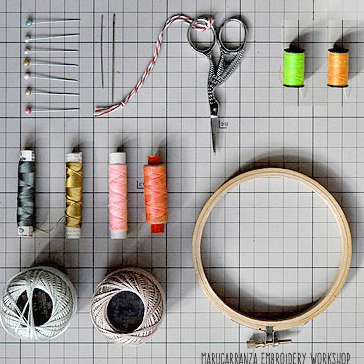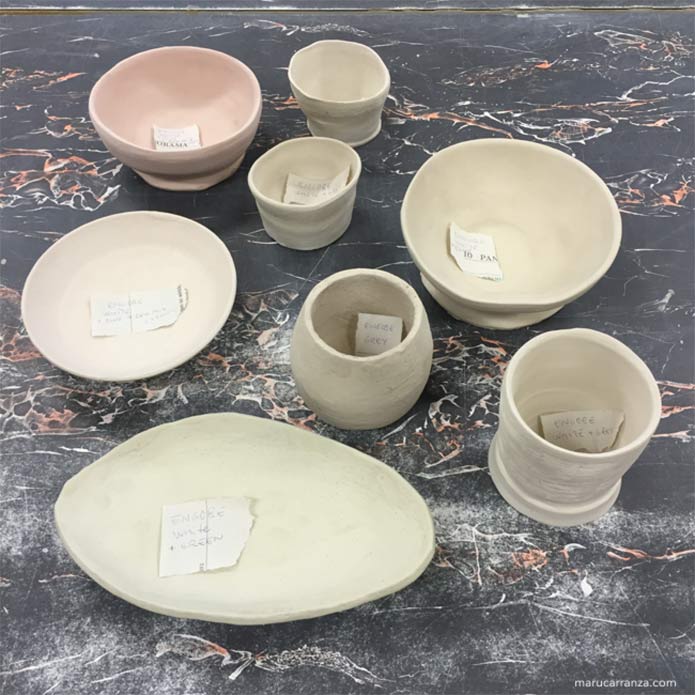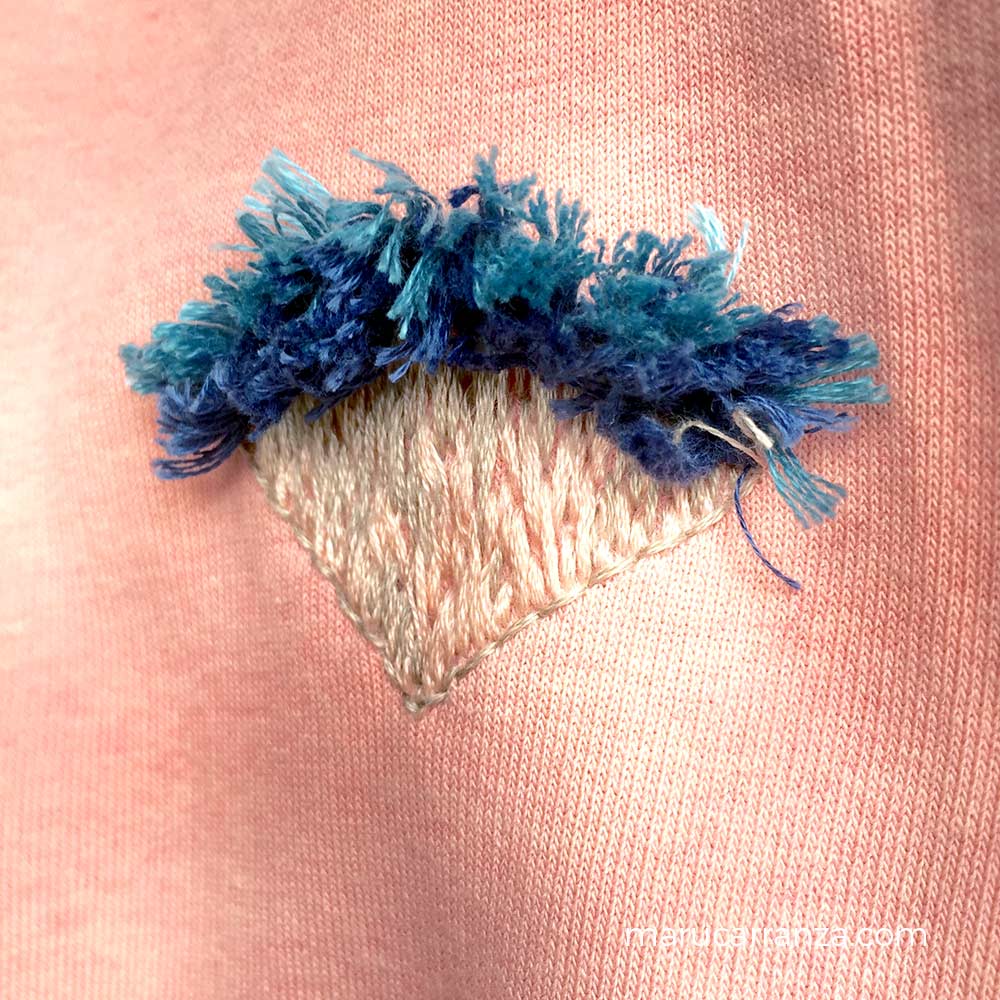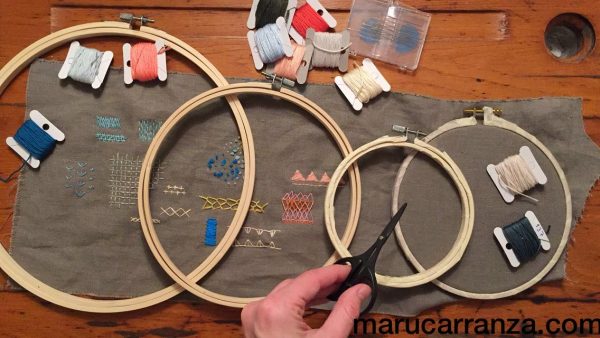
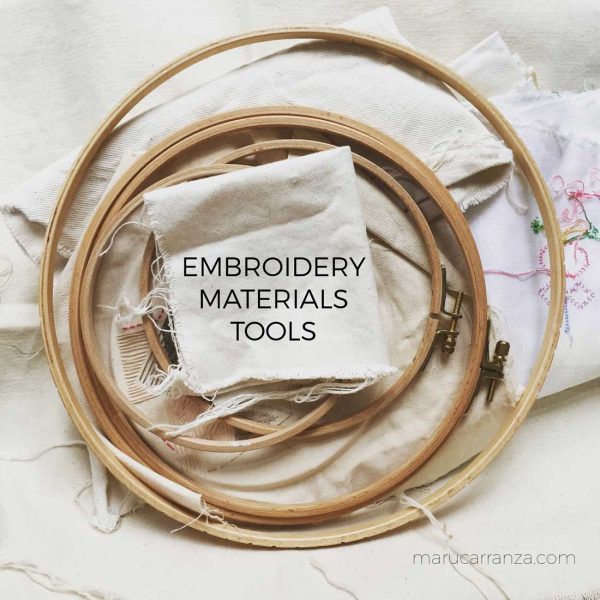
Embroidery Terms Glossary
The Embroidery Terms Glossary contains a wealth of embroidery terms and definitions and tons of process improvement information. Bookmark this valuable online FREE resource as it continues to expand.
A
3D Foam: Foam that is used to add dimension to an embroidery pattern that is typically used on caps. The 3D Foam is placed on the topside of the pattern and stitched over with shortened stitches to cut the Foam. The excessive foam is then pulled away from the embroidery giving a 3D appearance. 3D Foams are available in various thickness.
Appliqué: 1) Decoration or trimming cut from one piece of fabric and stitched to another, usually with a satin stitch, to add dimension and texture. If the appliqué occupies a significant amount of the design, the stitch count can be reduced. 2) In Schiffli embroidery, an embroidered motif is usually cut away from the base fabric and then stitched onto the finished product.
Arm Machine: Embroidery machine that has an arm or cylinder that the hook and bobbin are mounted in. Allows the use of special frames for embroidering caps, socks, inside pockets, etc. The cylinder-shaped arm allows goods to curve around the cylinder for embroidery.
Automatic Color Change: The ability of a multi-needle embroidery machine to follow a command to change to another specified needle with a different color thread in it. Many embroidery heads have as many as ten needles allowing the digitizer to program the use of ten different thread colors without stopping the machine.
B
Backing: Woven or non-woven material used underneath the item being embroidered to provide support and stability. Sometimes referred to as a stabilizer in the home embroidery market.
Backing can be large enough to be hooped with the item being embroidered, or placed between the machine needle plate and the hooped garment. Available in various weights and in various types of material that can be either in precut sheets or rolls. Backings can also be cutaway, tear-away, or specialty. See also Toppings & 3D-foam.
Bean Stitch: Three stitches placed back and forth between two points. Often used for outlining because it provides a bolder stitch appearance than a run stitch and requires fewer stitches than a satin stitch.
Bird Nesting: Collection of thread between the fabric being sewn and the needle plate that generally causes thread breaks and sewing problems. Bird nesting can be caused by improper thread tension (needle thread tension too loose); machine not threaded properly; bobbin case not installed properly; excessive flagging; and poor digitizing.
Bobbin: Small spool or reel that is wound with the thread used on lockstitch machines. Bobbins can be wound on the sewing machine or come pre-wound from the thread supplier. Generally, pre-wound bobbins contain much higher yardage than machine wound bobbins allowing for fewer bobbin changes. The most common bobbin size for embroidery machines is a style “L” bobbin, even though other special large hook machines may use style “M” bobbins. One of the most common pre-wound bobbins used is a T-16 (V-15) CF polyester bobbin.
Bobbin Case: Round assembly that applies tension to the bobbin thread and holds the bobbin in the machine. The latch mechanism locks the bobbin case into the hook. It is important that the embroidery machine operator be trained to properly install the bobbin case in the machine to minimize costly repairs of the machine. After the bobbin case in properly positioned to the bobbin case holder in the hook, it should then snap on the spindle when it is fully loaded. Most embroidery machines use an “L” size bobbin and bobbin case; even though sometimes larger hook styles are used.
Bobbin Tension: Bobbin thread tension should be set so very little thread is consumed in each stitch. Therefore, the bobbin thread is tight enough to consistently hold the needle thread down on the underneath side of the embroidered item. See tension.
Bridge Machine: Embroidery machine with two shafts, one for the hook assembly and one for the needle assembly. Sewing heads are suspended from a beam allowing for larger sewing fields than an arm machine. Bridge machines are accessible from both back and the front of the machine through the “bridge”.
Buckram: Coarse, woven backing fabric that is usually very stiff. It is used to stabilize fabric for stitching and commonly used in caps to hold the front panel with the embroidery pattern erect.
C
Cap Frames: Specialized embroidery frames (hoops) designed to hold finished caps for embroidering. Cap frames are available for flatbed machines where the finished cap flattened for sewing and for use on arm or cylinder bed machines for sewing the cap in it’s natural curved shape.
Chainstitch: Stitch that resembles a chain link formed with one thread fed from the bottom side of the fabric. Done on a manual or computerized machine with a hook that functions like a needle.
Check Spring: Part of the needle thread tension assembly or tensioner that assists in properly controlling the needle thread to set a good stitch with minimum sewing interruptions. See also take-up spring.
Chenille: Form of embroidery in which a loop (moss) stitch is formed on the topside of the fabric. Uses heavy yarns of wool, cotton or acrylic. Created by a chainstitch machine that has been adjusted to form this stitch type. Also known as loop piling.
Column Stitch: Formed by closely placed zigzag stitches that are often used to form borders. Also commonly known as satin stitch.
Complex Fill: Refers to a digitizing capability that allows areas to be designated as voids at the same time the design’s edges, or perimeter points, are defined. The design can thus be digitized as one fill area, instead of being broken down into multiple sections.
Condensed Fill: Method of digitizing in which a design is saved in a skeletal form. A proportionate number of stitches may later be placed between defined points after scale, density, and stitch lengths in a design may be changed. See expanded format.
Cylinder Spring: Refers to machines with “cylinder” beds. The hook assembly is housed in a cylinder-shaped arm, allowing goods to curve around the cylinder for embroidery.
D
Design: Stitches that compose a pattern or monogram.
Design Library/Catalog: A computer program that catalogs a collection of digitized designs kept by embroidery shops allowing an embroiderer to access the design by subject, stitch count, number of colors, or icon.
Digitize: The computerized method of converting artwork into a series of commands to be read by an embroidery machine’s computer. Digitizing is extremely important and will determine the quality of the finished embroidery. Every action of the embroidery machine is controlled by the digitized program including the movement of the pantograph to form various stitches, thread changes, thread trims, and many other functions. See punching.
Digitizing Tablet: A computer-aided design device used by digitizers to plot needle penetration for embroidery designs. Typically, a pencil drawing of the design is enlarged and then taped to this tablet. The digitizer then uses a mouse to select stitch types, shapes, underlay, and actual needle penetrations.
Disk Reader: An external or internal device used to read the digitized program that determines the embroidery machine movements.
E
Editing: Changing aspects of a design device via a computerized editing program. Most programs allow the user to scale designs up or down, edit stitches block by block; merge lettering with the design; move aspects of the design around; and combine designs or edit machine commands.
Emblem: Embroidered design with a finished edge; commonly an insignia of identification; usually worn on the outer clothing. Historically, an emblem carried a motto or verse or suggested a moral lesson. Also know as a crest or patch.
Embroidery: Embroidery is “thread art” used to embellish a garment, hat or some other product by adding a sewn pattern. Generally, this sewn pattern includes a design and can also include lettering and/or monograms.
Embroidery Machine: Today, embroidery machines can be defined as computer driven machines that move a pantograph with hooped items in various directions to form different stitches.
Embroidery machines can be single-head units or come in multiples of heads with multiple needles per head for production embroidery applications.
Embroidery Point: Unit of measurement in embroidery in which 10 points equals 1mm or 1 point equals .1 mm.
Expanded Format: A design program in which individual stitches in a design have been specifically digitized for a certain size. Designs punched in this format cannot generally be enlarged or reduced more than 10 percent to 20 percent without distortion because stitch count remains constant.
F
Fabric Grin Through: Where the fabric is seen through the embroidery design either in the middle of the pattern or on the edge. See also gapping.
Fill Stitches: One of the three most common stitches used in embroidery along with the run stitches and satin stitches. Fill stitches are used to cover large areas and they generally have a flat look. Altering the angle, length and direction of the stitched pattern can create different types of fill patterns.
Finishing: Processes performed after embroidery is complete. Includes trimming loose threads, cutting or tearing away excess backing, removing topping, cleaning any stains, pressing or steaming to remove wrinkles or hoop marks; and packing for sale or shipment.
Flagging: The up and down motion of the material with the needle that is caused by improper hooping, the presser foot not being properly adjusted (too much clearance with needle plate), and improper fabric stabilization (incorrect backing). Named because of its resemblance to a waving flag. Flagging generally causes improper needle loop formation that can lead to skipped stitches and thread breakage. Flagging can also negatively impact the appearance of the finished product resulting in poor design registration.
Flat Embroidery: Embroidery that is cut in panels or patches that is framed in hoops on a flat surface above the embroidery machine’s hook assembly.
Frame: Holding device for goods to be embroidered. Ensures stability of the goods during the sewing process. May employ a number of means for maintaining stability during the embroidery process, including clamps, vacuum devices, magnets, or springs. See hoop.
Frame Sash: Part of the pantograph to hold the frames. Also called a sash. Varieties of sash types include: border, frame, tubular, cap, and sock.
Framing Press: Machine used to aid the framing or hooping process.
G
Gapping: Where the fabric is seen through the embroidery design either in the middle of the pattern or on the edge. See also fabric grin through.
H
Hook Assembly: Stitch forming devise used to interlock the needle thread with the bottom thread. The hook assembly consists of the following components: hook base, bobbin case holder, retainer or gib, deflector plate, bobbin case, and bobbin.
Hoop: Device made from plastic, metal, or wood that grips the fabric tightly between an inner and outer ring and attaches to the machine’s pantograph. Machine hoops are designed to push the fabric to the bottom of the inner ring and hold it against the machine bed for sewing.
Hooping: Also called “framing”. The process where the item to be embroidered is loaded into a hoop. This hoop will later be loaded or attached to the pantograph for sewing.
Hooping Board: Board designed to hold the outer portion of the hoop while the goods to be embroidered are placed over the board to be hooped. Once the goods are aligned and placed correctly over the outer hoop, the operator inserts the inner portion of the hoop. Then the hoop is removed from the Hooping Board and attached to the pantograph for sewing. Helps ensure uniform placement of the hoop onto the material.
J
Jumbo Rotary Hook: Rotary hook, which holds a bobbin case with a much larger thread capacity than a standard hook.
Jump Stitch: Movement of the pantograph and rotation of the sewing head without the needle moving up and down. Used to move from one point in a design to another. Also, used to create stitches that are longer than the machine would normally allow.
L
Lettering: Embroidery using letters or words. Often called “keyboard lettering.” Usually computer generated either on the machine or a stand-alone computer.
Locking Stitch: Commonly refers to a series of three to four very small stitches (1 mm or less) either just before a trim or at the beginning of sewing following a thread trim. Also referred to as Tie In or Tie Off stitches. Used to prevent the stitching from unraveling after the embroidery is completed.
Lockstitch: The name used for a stitch that is formed with a needle and bobbin thread. The needle thread is interlocked with the bobbin thread to form a stitch. Also referred to as ISO4915, stitch number 301. On apparel sewing applications other than embroidery, a well-balanced lockstitch will use the same amount of needle thread as bobbin thread. On embroidery applications, this is not true because you never want to see the bobbin thread on the topside of the sewn product. Therefore the needle thread is held on the underneath side by the bobbin thread.
Lockstitch Machine: Machine that forms a stitch using a needle and hook assembly. Most embroidery machines are lockstitch machines.
Logo: Name, symbol or trademark of a company or organizations. Short for logotype.
Looping: Loops on the surface of embroidery generally cause by poor top tension or tension problems. Typically occurs when polyester top thread has been improperly tensioned. Looping can also occur as the result of a skipped stitch.
Low Speed Function: Setting on the machine that allows the machine to run at a lower speed than that set by the speed control knob.
M
Machine Language: The codes and format used by different machine manufactures within the embroidery industry. Common formats include Barudan, Brother, Fortran, Happy, Marco, Meistergram, Melco, Pfaff, Stellar, Tajima, Toyota, Ultramatic, and ZSK. Most digitized systems can save designs in these languages so the embroidery machine can read the computer disk.
Marking: Marking of goods to serve as an aid in positioning the frame and referencing the needle start points.
Mirror: A program menu option that allows reverse imaging of a pattern to be sewn. See also rotate pattern.
Modular: Machine system where many separate stitching heads or configurations of heads are controlled by a central computer.
Monogram: Embroidered design of one or more letters, usually the initials in a name.
Moss Stitch: See chenille.
N
Needle: The stitch forming devise that carries the thread through the fabric so it can be interlocked with a bobbin thread. Sewing machine needles generally have nine basic parts including the butt, shank, shoulder, blade, groove, scarf or spot, eye, point, and tip. Needles are available with various points. These include: Sharp points for piercing heavy, tightly woven fabrics; Ball pointed needles for sewing knits; and, A variety of specialty points for sewing leather and vinyl. Needles also come in many sizes. Two of the most common needle size systems are the metric size (i.e.,60, 70, 75, 80, 90); and the Singer numbering system (i.e.,9, 12, 14, 16).
Needle Bar: Bar that carries the needle up and down so a stitch can be formed. Each embroidery machine head can have up to 15 needle bars that can be selected to form the embroidery stitch pattern.
Needle Plate: The metal plate located above the hook assembly of an embroidery machine. This plate has a hole in the center through which the needle travels to reach the hook and form a stitch. Also know as a throat plate.
Network: 1) To link embroidery machines via a central computer and disk drive system. 2) A group of machines linked via a central computer.
Nippers: See thread clippers.
O
Offset: The ability to move the pantograph out of the stitching area with a specific movement and then return to the original point. Used for placing appliqués.
Origin: The starting point of your design.
P
Pantographs: A part of the embroidery machine that rests on the tabletop and moves the hoop to form the embroidery pattern.
Pantograph: The bar, rack, or holder on which frames or hoops are attached. The pantograph moves in X and Y directions to form the embroidery design, controlled electronically or mechanically depending on the machine.
Paper Tape: Media that is made from a continuous reel of paper or Mylar tape containing x-y coordinate information used to control the pantograph movement. Computer disks on newer machines have replaced paper tapes. Pattern storage media that is made from a continuous reel of paper or Mylar tape containing x-y coordinate information used to control the pantograph movement. Computer disks on newer machines have replaced paper tapes.
Pencil Rub: A low-cost way of producing a “sample” of an embroidery design. Accomplished by placing a piece of tracing paper over a sewn pattern and then rubbing lightly with a pencil to produce an impression of the embroidery.
Presser Foot: A metal ring around the needle that touches the fabric inside the hoop while the needle is down and beginning to rise to form a needle loop. The main function of the presser foot is to hold the fabric stationary until the hook point catches the thread loop formed by the needle. It helps to minimize flagging and therefore indirectly aids in loop formation.
Pre-Tensioner: Thread tension assembly that is located before that main tension assembly in the thread path. The function of the pre-tensioner is to apply a light amount of tension in order to remove any kinks in the thread prior to entering the main tensioner. See tensioner or tension assembly.
Puckering: Result of the fabric being gathered by the stitches. Causes include incorrect density, loose hooping, insufficient backing, or incorrect thread tensions.
Punching: Conversion of artwork into a series of commands to be read by an embroidery machine’s computer. Derived from an earlier method in paper tapes or Jacquards punched with holes controlled the movement of the pantograph and other commands. While still capable of producing paper tape, most computerized digitizing systems now store this information on a disk format.
Push and Pull Compensation: A degree of distortion built into a design by the digitizer to compensate for the push or pull on the fabric caused by the embroidery stitches. This can help prevent a digitized circle from looking like an egg shape when sewn out. Generally, it is necessary to extend horizontal elements and reduce vertical elements.
R
Registration: Correct registration is achieved when all stitches and design elements line up correctly. Poor registration can occur when the product being embroidered had not been hooped properly, improper digitizing, and excessive flagging.
Repeat: Layout used for making emblems or designs on a fabric span that are repeated at regular intervals.
Rotate Pattern: Program parameter that rotates the design in 90-degree increments counterclockwise, with or without mirror imaging the design.
Run Stitch or Running Stitch: Made when a single stitch is formed between two points used for outlining, underlay, and fine detail. Also known as a running stitch or walk stitch.
S
Satin Stitch: One of the three most common embroidery stitches used to produce an embroidery design. Formed by closely arranged zigzag stitches. Can be laid down at any angle and with varying stitch lengths. Commonly used for lettering and outlining. Satin stitches can range in width from 1.5 mm to 8 mm, however, the wider the satin stitch, the more susceptible they are to snagging and abrasion.
Scale: Program parameter used to expand or condense the size of the design without changing the number of stitches. A separate scale parameter is used for each direction.
Scanning: Scanners convert designs into a computer format allowing the digitizer to use even the most primitive artwork without recreating the design. Many of digitizing systems allow the digitizer to transfer the design directly into the digitizing program without using any intermediary software.
Short Stitch: A digitizing technique that places shorter stitches in curves or corners to avoid an unnecessary bulky build-up of stitches.
Specialty Fill: Allows the digitizer to produce special fill stitch patterns with a “relief” or motif design within the fill-stitch area.
Speed Control: Knob on the embroidery machine that allows the sewing speed to be adjusted up or down. On most modern embroidery machines, the speed at which the pattern is stitched varies according to the length of the stitch. Shorter stitches are made at higher SPM and longer stitches are made at slower SPM. This is necessary due to limitations of the movement of the pantograph and is also determined by the number of heads and/or hoops being driven by the machine.
SPI: Abbreviation for Stitches Per Inch. A system for measuring density or the amount of satin stitches in an inch of embroidery. See also Stitch Density. Most of today’s embroidery machines measure needle movement in .1 mm increments. Therefore a thread space of 4 would be .4 mm in length.
SPM: Abbreviation for Stitches Per Minute that normally is referring to the running speed of the embroidery machine. Typical embroidery machine speeds can vary but generally will be between 500 to 1000 SPM.
Stabilizer: See backing.
Stitch Density: Refers to the number of stitches used to give proper coverage of the pattern without creating a thick, hard area in the embroidery that may be uncomfortable to the consumer.
Stitch Editing: Digitizing feature that allows one or more stitches in a pattern to be deleted or altered.
Stitchback: Sewing function that traces back through a design so skipped stitches and thread breaks can be repaired.
Stock Designs: Digitized generic embroidery designs that are readily available at a cost below that of custom-digitized designs.
T
Tackle Twill: Letters or numbers cut from polyester or rayon twill fabric that are commonly used for athletic teams and organizations. Tackle twill appliqué’s attached to a garment have an adhesive backing that tacks in place; the edges of the appliqué’s are then zigzag stitched.
Take Up Spring: See check spring.
Tape Reader: A device attached to an embroidery machine that enables the machine to read an embroidery design from 8-channel paper computer tapes.
Tatami Stitch: Series of running stitches used to cover large areas. Different fill patterns can be created by varying the length, angle or repeating sequence of the stitches. Also called fill stitches.
Tear away Backing: A non-woven material placed under the fabric being embroidered to add stability to the fabric. Once the pattern is completed, this backing can then be torn off the design due to the needle penetrations. Typically used on more stable fabrics such as woven goods. When choosing a tear away backing, you should test to make sure it tears properly. If it doesn’t tear easily enough, it may pull out some of the stitches. If it doesn’t tear cleanly, it can leave an ugly, ragged edge. If the backing tears too easily, it may not provide enough support for the embroidery pattern.
Tension: Refers to the amount of tension applied to the threads by the sewing machine, which can be adjusted. Many embroiderers use the 2/3 Rule meaning that if you look at the underside of the embroidery after it has been stitched, that you should see approximately 2/3 needle thread to 1/3 bobbin thread. Normally this is easy to do because most embroiderers use a white bobbin thread. Loosening or tightening the needle and bobbin tensions can accomplish this. Proper machine thread tension is critical to quality embroidery.
Tension Assembly: Device used to apply tension to the needle thread to form a stitch. Consists of a tension post with take-up spring attached, tension discs, tension release disc, tension spring and tension nut.
Tensioner: Are the devices on the front of the machine head that controls the tension on the needle thread. Each needle and thread position has its own Tensioner and all of them should be set as close as possible to get quality stitching. The thread tension assembly normally consists of a post, thread tension knob, tension spring and two tension discs. When the thread tension knob is turned clockwise, it screws down on the post compressing the tension spring on the tension discs. This applies more pressure on the needle thread that is sandwiched between the two tension discs and is against the post. More tension will pull more needle thread from the underside allowing more bobbin thread to be seen.
Thread: Embroidery can be sewn with many types and sizes of threads depending on the desired finished appearance. Embroidery threads are commonly made from rayon, polyester, cotton and metallics. Rayon threads are generally made with a twisted multifilament construction and have a high sheen. Polyester threads can be made in three different thread constructions including a twisted multifilament, air entangled and spun construction. Obviously, cotton threads are only made in a spun construction. Both spun polyester and spun cotton thread have a “matte” or low sheen appearance. Rayon and Polyester filament threads have a high sheen. Polyester is stronger than Rayon and has superior color fastness and abrasion / chemical resistance. Metallics are filament threads that have the highest luster and are formed with a synthetic core wrapped in metal foil. Generally metallic threads do not sew as well as polyester or rayon threads. The most common ticket size for rayon or polyester embroidery threads is a No. 40, however other sizes are available. A&E’s Signature polyester embroidery thread comes in a variety of sizes including a No. 40, 30, 20, 10 and 3004 used for serging appliqués.
Thread Break Detector: Device that detects thread breakage and stops the machine automatically allowing the operator to rethread the needle and restart the machine. On multi-head embroidery machines, when the needle thread breaks on one head, all the machines stop. Therefore, using a thread that will minimize thread breakage is recommended to optimize stitching time.
Thread Break Indicator: Small light on the front of the sewing head that flashes when a thread break is detected.
Thread Clippers: Small spring loaded scissors designed to be operated with just the thumb and forefinger. Used to clip the thread.
Tie In Stitches: Small stitches used at the beginning of a sewing cycle, particularly on satin stitches, to prevent the thread from pulling out of the embroidery. See also tie off stitches.
Tie Off Stitches: Small stitches, usually about 1 mm in length that “lock” the stitches in the fabric to prevent the stitch from unraveling when the thread is trimmed. Without Tie off stitches the thread can potentially unravel and destroy the embroidery. They are particularly necessary when making satin stitches wider than 1.2mm, as satin stitches have a tendency to unravel more easily than running or fill stitches.
Topping: Materials hooped or placed on top of fabric that have definable nap or surface texture, such as corduroy and terry cloth, prior to embroidery. It provides a smooth surface so that the stitches can be laid down properly and prevents the wale or nap from interfering with proper stitch appearance. Includes a variety of substances, such as plastic wrap, water-soluble “foil” and open-weave fabric that has been chemically treated to disintegrate with the application of heat. Also known as facing.
Trimmers: Thread trimming device located under the needle plate in the embroidery machine used to automatically cut the needle and bobbins threads before the design jumps from one area to another or performs a color change. This trimming is done when the needle is out of the work and the take-up is near the top of its stroke.
Trimming: Operation in the finishing process that involves trimming the reverse and top sides of the embroidery, including jump stitches and backing.
Tubular Embroidery: Embroidery produced on a cylinder bed embroidery machine that allows tubular fabric or pre-assembled garments (i.e. sleeves). Allows sewing a part or the garment after it has been assembled, as compared to using a flatbed machine to sew fronts or sleeves prior to assembly the garment.
U
Underlay Stitches: Stitches in a design that are put down before the design stitches; used to stabilize the fabric or raise the design so that the fine detailing is not lost.
Variable Sizing: Ability to scale a design to different sizes.
Verify: Sample Sew-out of a new embroidery design to make sure the pattern is correct.
Walking Stitch: See running stitch


